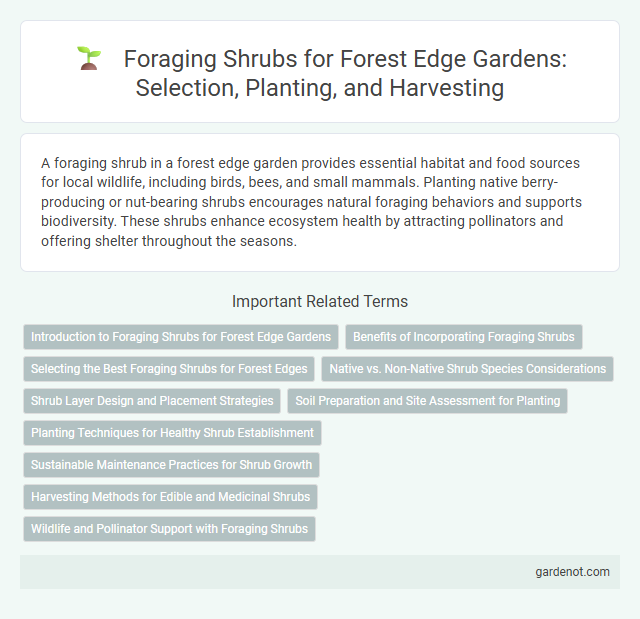A foraging shrub in a forest edge garden provides essential habitat and food sources for local wildlife, including birds, bees, and small mammals. Planting native berry-producing or nut-bearing shrubs encourages natural foraging behaviors and supports biodiversity. These shrubs enhance ecosystem health by attracting pollinators and offering shelter throughout the seasons.
Introduction to Foraging Shrubs for Forest Edge Gardens
Foraging shrubs in forest edge gardens provide a rich source of edible fruits, nuts, and medicinal plants while supporting local biodiversity. Common species like serviceberry, elderberry, and hazelnut thrive in these transitional habitats, offering seasonal yields that encourage sustainable harvesting practices. Integrating foraging shrubs enhances ecosystem resilience and creates a multifunctional landscape for food production and wildlife habitat.
Benefits of Incorporating Foraging Shrubs
Foraging shrubs enhance biodiversity by attracting pollinators and beneficial wildlife, which supports a healthy forest edge garden ecosystem. They provide edible fruits, nuts, and leaves that contribute to sustainable food sources and seasonal foraging opportunities. Incorporating these shrubs improves soil health through nitrogen fixation and organic matter accumulation, promoting long-term garden productivity.
Selecting the Best Foraging Shrubs for Forest Edges
Selecting the best foraging shrubs for forest edges involves prioritizing species that thrive in partial shade and support local wildlife while providing edible fruits or leaves. Native shrubs like elderberry (Sambucus canadensis), serviceberry (Amelanchier alnifolia), and chokeberry (Aronia melanocarpa) offer high nutritional value and attract pollinators, boosting ecosystem health. Incorporating diverse foraging shrubs enhances biodiversity, ensures sustainable harvests, and strengthens forest edge resilience against environmental stressors.
Native vs. Non-Native Shrub Species Considerations
Native shrubs in a forest edge garden provide essential ecological benefits by supporting local wildlife and promoting biodiversity. Non-native shrubs may offer aesthetic or functional advantages but risk disrupting native plant communities and altering soil chemistry. Careful selection of foraging shrubs prioritizes native species to maintain ecosystem balance and resilience.
Shrub Layer Design and Placement Strategies
In forest edge garden design, selecting native foraging shrubs such as elderberry, serviceberry, and hazelnut optimizes fruit production and biodiversity within the shrub layer. Strategic placement involves positioning these shrubs in partial sunlight zones along the transition from canopy trees to understory plants, enhancing sunlight exposure and facilitating pollinator access. Incorporating shrub layers with staggered heights and spacing promotes efficient nutrient cycling, pest control, and sustainable yield in permaculture systems.
Soil Preparation and Site Assessment for Planting
Foraging shrubs thrive in well-drained, nutrient-rich soil with a pH ranging between 5.5 and 7.0, demanding thorough site assessment that includes soil texture, moisture levels, and sunlight exposure. Effective soil preparation involves incorporating organic matter such as compost or well-rotted manure to improve fertility and structure, promoting healthy root development. Selecting a site with partial to full sun and ensuring adequate spacing helps optimize growth and fruit yield for sustainable foraging benefits.
Planting Techniques for Healthy Shrub Establishment
For optimal foraging shrub establishment in a forest edge garden, select well-drained soil enriched with organic matter to support robust root development. Plant shrubs during early spring or late autumn to leverage dormant periods, ensuring slower moisture evaporation and enhanced nutrient uptake. Consistent mulching and regular watering during the first growing season are critical to reduce stress and promote healthy shrub growth.
Sustainable Maintenance Practices for Shrub Growth
Foraging shrubs in a forest edge garden thrive through sustainable maintenance practices such as minimal soil disturbance, organic mulching, and native species selection to enhance biodiversity. Regular pruning encourages healthy growth and maximizes fruit or leaf yield, while allowing natural wildlife habitats to flourish. Implementing rainwater harvesting and avoiding chemical fertilizers ensures long-term soil fertility and ecological balance.
Harvesting Methods for Edible and Medicinal Shrubs
Harvesting methods for foraging shrubs in a forest edge garden emphasize selecting ripe fruits and leaves at peak nutritional value to maximize medicinal and edible benefits. Employing hand-picking techniques minimizes damage to the plant, ensuring sustainable regrowth and continuous harvests throughout the season. Proper identification and timing, such as harvesting morning dew before full sun exposure, preserve potency and prevent spoilage of valuable shrub resources.
Wildlife and Pollinator Support with Foraging Shrubs
Foraging shrubs such as elderberry, serviceberry, and beautyberry provide vital food sources for a variety of wildlife, including birds, mammals, and beneficial insects. These shrubs offer nectar-rich flowers that attract pollinators like bees and butterflies, enhancing biodiversity and ecosystem resilience. Incorporating foraging shrubs in forest edge gardens supports wildlife habitats and promotes natural pollination processes essential for healthy plant communities.
Foraging shrub Infographic

 gardenot.com
gardenot.com